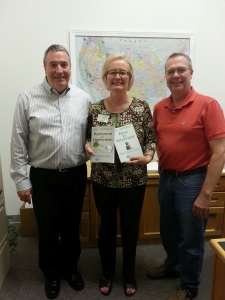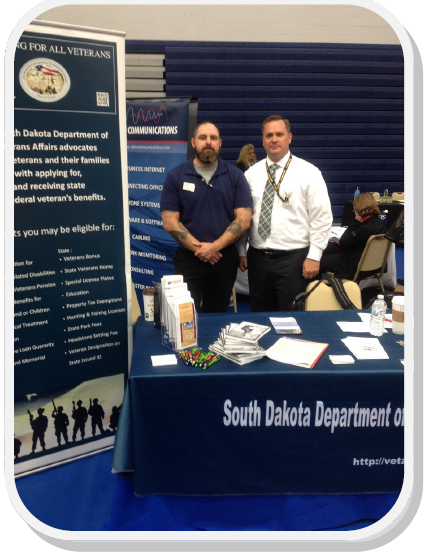Just had a visit by Santa and Mrs. Claus before they left to spread some Christmas cheer to the elderly in our community. Thank you Santa and Home Instead Senior Care! #homeinstead #Beasantatoasenior

Just had a visit by Santa and Mrs. Claus before they left to spread some Christmas cheer to the elderly in our community. Thank you Santa and Home Instead Senior Care! #homeinstead #Beasantatoasenior

Authored By: A.T. Houston
The Marines have a saying, Semper Fidelis, which means always faithful. Former Marine and the co-founder of Six Sigma, Dr. Mikel Harry continues to sponsor a Lean Six Sigma Black Belt scholarship program to help veterans transition to six-figure positions by offering companies their mastery of business process improvement skills.
Dr. Harry has many success stories regarding the program which commenced in early 2013. He shared a Gulf War Veteran’s letter recently on his blog,
“Within weeks of completing the certification and working with you, I accepted an offer of employment today for a full-time permanent supply chain project manager position. My starting salary is $100,000.00 per year with a $5,000.00 signing bonus, plus excellent benefits. The bar is very high, and now it is time to get to work.”
Through Leatherneck.com, Six Sigma Wings for Heroes (SSWH) is awarding scholarships to Marine veterans, reservists, active-duty personnel, and family members.
SSWH is not asking for any donations, matching contributions, or economic pledges. Rather, Dr. Harry has dedicated himself to fund the scholarships as his way of making a difference to those who have sacrificed so much for our nation.
Leatherneck.com is asking Marines to submit a personal letter via email, stating the reason(s) they want the scholarship and how they feel it would impact their chances at finding work and advance their post military careers.
Letters should be sent to SixSigmaWingsforHeroes@leatherneck.com. Leaders atLeatherneck.com and SSWH will review all submissions and award the scholarships based on the impact and creativity of the entries. The program will continue until all 300 scholarships donated have been granted.
About Six Sigma Wings for Heroes
A dimension of Six Sigma Management Institute (SSMI) is about giving back to the men and women that have safeguarded our great nation and sacrificed so much on our behalf.
Join VA, representatives from the Institute for Veterans and Military Families and Student Veterans of America, and other Veterans for a Facebook chat about VA education and employment benefits and services.

Guest Blog
By: Morag Barrett

Coaching is normally thought of as something that is bought in. You need a coach? You go out and get one. Maybe you always wanted one; and maybe you could only watch as your peers received the advice that you wanted from one, but didn’t.
You know, there are likely to be people who work for you who feel the same way. While there may not be coaches within your company and which they have no access to, no doubt they have friends in other companies who are benefiting in this way.
Although external coaches can bring in outside expertise as well as a fresh perspective, you are in the best position to coach your people. You see them every day. Why not take advantage of that opportunity?
In order to understand how coaching fits into organizations today, we need to revisit traditional supervision.
It started life as close supervision. It’s still used to a certain extent today. Any place where the employee has comparatively little skill compared to what is needed at the moment. It’s been said that every new employee is incompetent for six months. That’s because it takes time to learn how the organization does things. Even within the same one, different locations have their idiosyncrasies. But close supervision shouldn’t last for very long. If it does, then there will be for just one of three reasons: you’re a micro-manager; you’re a poor teacher, or you hired the wrong person.
The second type and most popular type of supervision is what might be called laissez-faire. Instead of pointing out every step, as you do with close supervision, this type is more like “course correction.” In it, your goal is to get people up and running as quickly as possible, and then to let them get on with whatever it is that they need to do. Of course, you make yourself available for help. All they have to do is ask. But for the most part, you try to leave them alone. Most employees prefer this approach, too.
The third type is coaching. This could be called a strategy for excellence. It’s using the idea of “letting people get on with their jobs” as a means, rather than an end. The end is excellence in everything: To be the best they can be so that they can be promoted so that they can develop their career so that they can coach others. The end with laissez-faire is just to let people get on with their jobs; but there’s no goal beyond that.
You may be thinking, “So what’s wrong with that? Why bother to coach people? They’ll just leave anyway, and I’ll have to start all over again.”
You may even be thinking that there are a lot of people waiting in the wings who’d be all too happy to take the job of your employees, and that because of that you don’t need to coach anyone. If that’s what you’re thinking, then you need to be aware of something. There’s a shortage of people who are skilled to the level that you want them to be. There aren’t enough to go around. And if it really does take six months to bring someone who already knows for the most part what to do up to a level where they can contribute real value to your organization on their own, then you can see already that it’s essential for you to hold onto the people you have.
Most people don’t really want to leave their current place of employment. They want to be happy where they are. Moving is a hassle at the best of times. You have to sell the house, pack your stuff, move it yourself or give it to a moving company. You have to find a place to live at the other end, buy or rent, move your stuff in, and deal with the utility and internet companies. It’s a nightmare. If you have children in school, it’s worse.
The only reason that people will leave is if they feel that you’re holding them back. As long as they feel they’re being sufficiently challenged, that they’re advancing, that they’re being compensated fairly for what they do and that you respect and value them, they’ll stay with you. And that means that you need to be their coach. In fact, you should always be coaching them.
Close supervision is simply telling people what to do. At the other extreme is laissez-faire – hardly ever doing so.
Coaching is different. In it you’re tailoring your guidance according to the needs and abilities of the individual employee; not just the organization; and when you do that, both you and those you coach benefit more than if you did nothing.
Coaching demonstrates that you value your employees. There simply is no substitute for providing individual help and encouragement.
Do you think that you’re too busy to do this? This is the most important part of any day you care to name.
Whatever else you have to do, it won’t happen without the people in your charge. You can do it with them, or you can do it alone.
It’s up to you.
Morag Barrett is the best-selling author of Cultivate: The Power of Winning Relationships and CEO of SkyeTeam, an international HR consulting and leadership development company. Morag’s experience ranges from senior executive coaching to developing leaders and teams across Europe, America and Asia. SkyeTeam works with clients in a range of industries including: Healthcare, Telecoms, Mining, Manufacturing, Engineering, and Technology.
Guest Blog by
Nicole Abrahams

Image credit: Atsuke, license Attribution-NonCommercial-NoDerivs 2.0 Generic (CC BY-NC-ND 2.0) Image source: https://www.flickr.com/photos/atsuke/4613987073
These days, it is quite common to hear people complain about age discrimination in regards to seeking employment. Younger job seekers feel that they are brushed over by hiring managers because they lack experience. Older job applicants feel that they are disregarded because they are viewed as outdated. However, it is likely that many members of both groups are not being hired for reasons other than their birth dates. With this in mind, read the following for tips on how to land your dream job at any age.
Maintain the Right Image
Perhaps in a perfect world appearances wouldn’t matter. However, in today’s competitive business environment, they do. As such, whether you are young or old, you need to be aware of what the current trends in business dress are. If you are fresh out of college, make sure you don’t look like a kid pledging at a fraternity. Likewise, if you have a few more years under your belt ensure that your wardrobe is up to date and that you don’t appear to live in a retirement home. Regardless of your birth date, you should:
Guest Blog
by Jone M. Bosworth, J.D.

Jone M. Bosworth, J.D.
Visiting a dear friend in Omaha recently, she shared something one of her Catholic priests mentioned to her: “He said that he was walking out of a restaurant one night, wearing his collar, and an apparently homeless woman stopped him and said, hey, I like your Pope.”
Once I got past the sense that this embodies the makings of a good joke, and consternated about whether the priest had done something immediately to assist the woman (he didn’t, at least according to the second-hand story), I realized that I was in radical agreement with the homeless woman: I like Pope Francis’ leadership thus far too.
I’m not Catholic but I do recognize that popes are incredibly important global CEOs. Because how they lead matters to so many, it also matters to me. According to the Vatican, there are 1.2 Billion Catholics in the world today. In the U.S., 72.8 people self-identify as Catholics.
When His Holiness Pope Francis presented the vision for his papacy, he showed who he is as a leader. He called on Catholics to battle the “globalization of indifference” and challenged the church to be more compassionate, to champion the poor and work to achieve social justice.
Five Francis-Catalyzed Leadership Reflections
Leadership, however, isn’t really about popularity but about influence, integrity — using your ‘whole person,’ your skills, knowledge, your gut and heart instincts—to do the right thing. Impressively, Pope Francis sent out a survey to gain followers’ perspectives—that’s leading.
We are very happy to have partnered with the South Dakota Department of Labor in providing 150 books for a recent military job fair is Sioux Falls, South Dakota. The books “Deployment to Employment: A guide for military veterans transitioning to civilian employment” and “How to interview: What employers want to hear in today’s competitive job market” were distributed to our military veterans to assist in their job search.
Pictured below is Jim Prostrollo, Employment Specialist – Veteran’s Services and Wylla Satterness, Employment Specialist – Business Outreach along with Directional Motivation Founder and Author Russ Hovendick

Article Credit South Dakota Department of the Military South Dakota Department of Veterans Affairs
The South Dakota Department of Veterans Affairs was one of over 100 vendors at the Sioux Falls Job Fair held at the Elmen Center at Augustana College Wednesday.
Deputy Secretary Aaron Pollard, Field Officer Steven Lund and Veterans Service Officer Regina Boeve were on hand to answer questions regarding veterans benefits and services.
Sioux Falls Mayor Mike Huether kicked off the event by reading a proclamation proclaiming Wednesday, August 6, as Veterans and Spouses Job Fair Day in Sioux Falls.
This is the eighth annual job fair offered to assist veterans, military personnel readjust to their civilian life.
Recently, SDDVA provided all CTVSOs with the book “Deployment to Employment,” a guide for military veterans transitioning to civilian employment. The book provides a step-by-stepguide to success in landing civilian employment. SDDVA Secretary Zimmerman believes that the book is a great resource for veterans to use in developing their resume, preparing for interviews and landing a job.

The winner of our Directional Motivation Scholarship is Jason Hsieh. Jason is currently an undergraduate student studying at the University of Southern California, aspiring to become a pediatrician. He works with children after school to educate them on numerous areas of health such as eating well and anti-bullying. At the same time, he is also a researcher at the Keck School of Medicine Stem Cell Center learning about the regenerative abilities of periosteums surrounding the bone. When he needs to step away from science and academics, he says he likes to focus on dance – letting his emotions and stress escape through his body as he surrounds himself with music. Congratulations Jason!

This is one that hits home for me for many reasons. Professionally speaking, I’ve always been good about speaking up and making my intentions known. I tend to be pretty open with my boss about what I want out of my career and how I plan to get there. I will ask for a challenging task, a raise, and even a promotion because the fact is, nobody is really going to do that for you. I attribute this to my growth and learning in the military. My trouble, however, lies in the initial acts of doing. Now, I’m not saying I don’t get it done. I pride myself on my work and my efficiency. What I’m referring to is the reaching out of my ‘comfort zone’ to get started on those things that I want. I won’t lie I’m a bit of a procrastinator when it comes to getting started. It’s the apprehension of doing something new that really gets to me and delays my initial reaction. It’s been this way MY ENTIRE LIFE! From learning to swim and riding a bike to even sliding down a park slide for the first time – embarrassing. I digress.
The whole concept of reaching out of my ‘comfort zone’ is intimidating, especially in a professional setting. Can you relate?
I think everyone can on some level. We all have a fearful place that we ignore or sidestep. We let others be the doers and see them reap the benefits. Well, let me tell you this from my personal experience…you can do it – it can be done! If you can dig down deep and suppress your apprehensions of doing something fearful, you will experience both success and true satisfaction. I now realize that this has been true throughout my life, but only recently, and as I begin my new business venture, have my eyes been opened to this epiphany. I’ve stepped outside that ‘zone’, survived, and prospered! I guarantee the same will be true for you. So please, heed my words…’comfort zones’ are overrated!
A few lessons learned:
• Latch onto someone that pushes your limits and holds you accountable to your goals and dreams – a spouse, a mentor, a boss, a coach, anyone.
• Take a deep breath, say a quick prayer (if you do that), and leap!
• Believe in yourself and your abilities. You have no idea what you are capable of until you try, and believe me you are capable.
• Realize why you are doing what you are doing, and do it!
Read More →
| M | T | W | T | F | S | S |
|---|---|---|---|---|---|---|
| « Dec | ||||||
| 1 | 2 | 3 | 4 | 5 | ||
| 6 | 7 | 8 | 9 | 10 | 11 | 12 |
| 13 | 14 | 15 | 16 | 17 | 18 | 19 |
| 20 | 21 | 22 | 23 | 24 | 25 | 26 |
| 27 | 28 | 29 | 30 | 31 | ||
